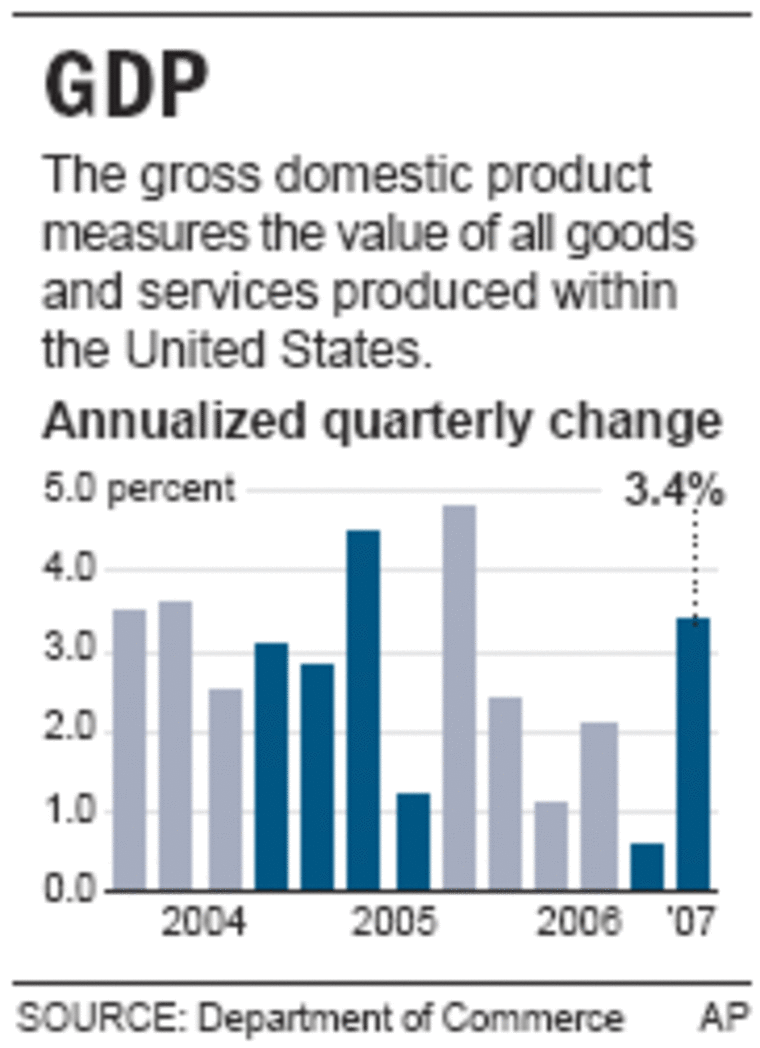The economy snapped out of a lethargic spell and grew at a 3.4 percent pace in the second quarter, the strongest showing in more than a year. A revival in business spending was a main force behind the energized performance.
The new reading on gross domestic product, released by the Commerce Department on Friday, marked a big improvement from the first three months of this year, when economic growth skidded to a near halt at just a 0.6 percent pace, the slowest in more than four years.
At the White House, President Bush said job growth has been strong and the economy is resilient and flexible. “I want the American people to take a good look at this economy of ours,” Bush crowed.
Stronger spending by businesses and government powered the rebound in the April-to-June quarter. Individuals, however, tightened their belts as they coped with high gasoline prices and the ill effects of the housing slump. The sour housing market continued to weigh on national economic activity in the spring but not nearly as much as it had in previous quarters.
Inflation — outside a burst in energy and food prices — moderated.
Treasury Secretary Henry Paulson called the market volatility a “wake up call” to investors to re-examine their degree of risk.
“What we are seeing is risk being repriced and a different perspective on risk which is healthy,” Paulson said in a CNBC interview. “I think we can use some more discipline.”
The second quarter’s performance was better than the 3.2 percent growth rate economists were expecting. It was the strongest showing since the first quarter of 2006, when the economy expanded at a brisk 4.8 percent annual rate.

Gross domestic product measures the value of all goods and services produced in the United States. It is considered the best barometer of the country’s economic fitness.
“I think the confidence level of companies has come back. That’s why there was a modest pickup in capital spending,” said Ken Mayland, president of ClearView Economics.
Even as the economy picked up speed in the spring, inflation managed to settle down.
An inflation gauge closely watched by the Federal Reserve showed “core” prices — excluding food and energy — rose at a rate of just 1.4 percent in the second quarter. That was down sharply from a 2.4 percent pace in the first quarter and was the smallest increase in four years.
That should help ease some inflation concerns. Fed Chairman Ben Bernanke has said the biggest threat to the economy is if inflation doesn’t recede as policymakers anticipate. Out-of-control prices are bad for the economy and the pocketbook. They eat into paychecks, erode purchasing power and reduce the value of investments.
The Fed has kept a key interest rate at 5.25 percent for more than a year. Economists predict that rate will stay where it is through the rest of 2007.
The president, after one of his regular meetings with his economic team, praised the economy to reporters: “People are working. The unemployment rate is down. Wages are increasing.”
Bush has been trying to counter weak public-approval ratings for his economic stewardship. Only 37 percent approve of his performance, close to a record low, according to a recent AP-Ipsos poll.
The ailing housing market is still crimping economic activity, but not as much as it had.
Investment in home building was cut by 9.3 percent, on an annualized basis, in the second quarter. That wasn’t nearly as deep as the 16.3 percent annualized drop in the first quarter. It was the smallest cut in just over a year.
Businesses, meanwhile, regained their appetite to spend and invest in the second quarter.
They boosted their spending on new plants, buildings and other commercial construction at a whopping 22.1 percent rate, the most in 13 years. Investment on equipment and software posted a 2.3 percent growth rate, an improvement from a meager 0.3 percent growth rate in the first quarter.
Businesses also replenished their inventories in the second quarter, adding to overall economic growth. Stronger export growth helped the nation’s trade picture and added to the economy’s momentum.
Also contributing to the second quarter’s rebound: Government spending increased at a 4.2 percent pace. That compared with a 0.5 percent annualized drop in the first quarter.
However, consumers, whose spending largely prevented the economy from stalling out in the first three months of this year, lost energy in the second quarter. They boosted spending at a pace of just 1.3 percent, the smallest since the final quarter of 2005.
High gas prices and fallout from the housing slump are beginning to take their toll on peoples’ appetite to spend. Still, a solid jobs climate — the nation’s unemployment rate is at a relatively low 4.5 percent — should help cushion some of these negative forces.
The government also issued annual revisions that showed the economy grew at an average annual rate of 3.2 percent from 2003 through 2006, or 0.3 percentage point less than previously estimated. The revisions are based on more complete data.
Last year the economy grew by 2.9 percent — slower than the 3.3 percent increase previously calculated. The new figure marked the weakest annual growth since 2003 and underscored the depth of the housing slump.